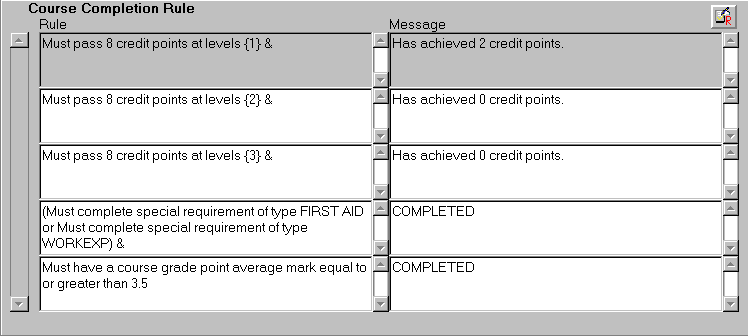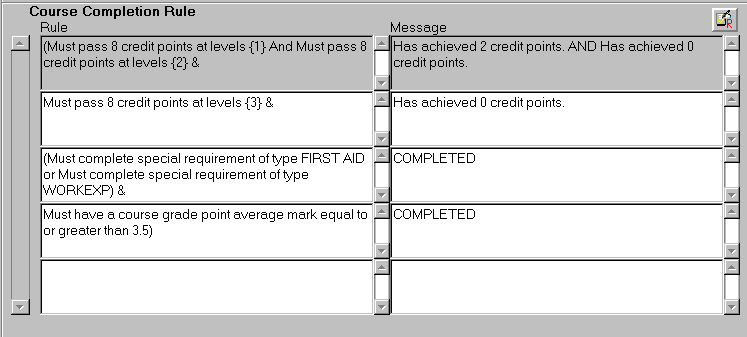In this section:
The syntax, rule operators and parameters for the various types of completion rules is described in more detail in the relevant rule documentation — Unit Set, Course Stage or Course Version.
The means to construct completion rules that specify the requirements for completing a course version, course stage and unit set are provided through the Rules subsystem. Using this functionality provides an institution with the opportunity to clearly define completion requirements for both component parts of a course (unit set and course stage) and the course version.
The application of these completion rules to a Student Course Attempt allows staff (and the student where access is provided as part of a self-serve facility) to determine whether a student has completed (or can complete, based on current enrolment) these requirements. This functionality is provided through the Progression subsystem. The result of testing completion rules (based on the academic requirements) can be used as one of the measures on which an institution can base its decision to classify a student course attempt as complete.
This testing of completion rules does not automatically flag the Student Course (or Unit Set) Attempt as complete. To mark a student course attempt as complete, the Rqrmnts Complete indicator must be set in PRGF4170, after an institution's has determined that academic requirements and other obligations have been satisfied. The setting of this indicator marks the student eligible to graduate from that course version. The process of setting the Completed indicator (on ENRF3252) against a Unit Set should follow the testing of a Unit Set completion rule, where a student satisfies the academic requirements of that unit set.
To determine whether course, course stage or unit set requirements have been satisfied, institutions commonly evaluate a student course attempt based on combinations of the following measures:
The options available for constructing completion rules allow any one or combinations of these measures to be used. The complete syntax of rule options using these measures, is described in the documents: Course Version Rules, Course Stage Rules, Unit Set Rules.
Conditional Completion Rules can be used to determine whether course, course stage or unit set requirements have been satisfied based on the conditional criterion. For example, the completion requirements for a course might have altered for students enrolled after a specified date. In this case a conditional completion rule is used. It specifies the date the requirements changed and both sets of completion requirements.
Example of a Conditional Completion Rule
For commencement date before 14/2/1988 Do
Must pass 1 unit {MAA101}
Otherwise
Must Pass 1 unit {SCC101} & Must complete 1 course {M300}
The options available for constructing completion rules allow any one or combinations of these measures to be used. The complete syntax of rule options using these measures, is described in the documents: Course Version Rules, Course Stage Rules, Unit Set Rules.
The ability to create and maintain completion rules exists at three levels in the course structure. These levels are:
In each case, the text of the rule is constructed in RULF2000, accessed from the applicable form, in the context of a Completion Rule Description.
All rule options relevant to completion (of the context course structure component) can then be displayed in RULF2000, using the Options/Validate button. A rule can be constructed by either entering text directly into the Rule Text box or by selecting from the available Rule Options, validating that option and selecting/completing the next option displayed, until the required text has been built.
Where an option not applicable to a completion rule is entered, the rule does not 'parse' successfully and cannot be saved. Similarly other syntax errors in the rule text do not parse and cannot be saved.
A course version completion rule can be made up of complex course completion requirements. The use of course stages and unit sets to construct the Course Version completion rule allows this complexity to be represented with more clarity. Where an institution has structured its courses using unit sets and/or course stages, a logical approach to building a course completion rule may be to include measurement of the completion of these component parts (plus any additional completion measure, such as achieving the required credit points for the course). Completion of other courses can also be used as one of the measurements evaluated. This approach is particularly relevant for articulated courses. For example completion of a post-graduate Masters course may require that a Graduate Diploma course has been completed.
A course completion rule that includes evaluating the completion of another course, course stage or unit set evaluates those 'components' as follows, to determine the overall result for the Student Course Attempt in relation to the course completion rule.
Example:
Must complete stage of type YEAR-01 And Must complete stage of type YEAR-02 And Must complete
stage of type YEAR-03 &
Must have completed 1 unit sets of category MINOR And Must have completed 1 unit sets of category MINOR &
Must complete 24 credit points
Example Rule:
Must pass 8 credit points at levels {1} &
Must pass 8 credit points at levels {2} &
Must pass 8 credit points at levels {3} &
(Must complete special requirement of type FIRST AID or Must complete special requirement of type WORKEXP) &
Must have a course grade point average mark equal to or greater than 3.5
An example of this rule evaluation function:
| Rule Component | Explanation | Pass or Fail? |
| 1. Must pass 8 credit points at levels {1} | Tests if the Student Course Attempt has the passed number of credit points at level |
F |
| 2. Must pass 8 credit points at levels {2} | Tests if the Student Course Attempt has the passed number of credit points at level |
F |
| 3. Must pass 8 credit points at levels {3} | Tests if the Student Course Attempt has the passed number of credit points at level |
F |
| 4. Must complete special requirement of type FIRST AID or Must complete special requirement of type WORKEXP |
Tests if the Student Course Attempt shows one or the other special requirement has been completed |
P |
| 5. Must have a course grade point average mark equal to or greater than 3.5 | Tests if the Student Course Attempt shows the required GPA value |
P |
| Overall Course Version Completion Rule Result: | Because 3 of the 5 component 'rules' are failed (Rules 1, 2 and 3 ) the overall Course Version Completion Rule is Failed |
Fail |

The '& operator is used to link 5 individual 'rules' into a single completion rule. The completed rule text is displayed with a vertical separation at each ampersand. Each of these components is evaluated by the rule testing process as a separate component.
The 'And' operator is described as a logical conjunction — that is it allows the joining of two rule options into a single component part. The rule testing process evaluates this as a single rule and both conditions must be true for it to be passed. This can be seen in the example below, where both levels 1 and 2 are evaluated together and a single message returned.
The 'or' operator is a logical OR. Two (or more) rule options are logically evaluated as a single rule. For a 'pass' result to be returned, at least one of the options must be true. In the example above the student has completed the WORKEXP special requirement and therefore satisfies this component of the completion rule.
The ( ) operators are used to force execution of the parts of a rule enclosed within the brackets before those outside the brackets. Whenever brackets are used there must be an equal number of left and right brackets. When a rule is saved, brackets may be added around the rule text to maintain a balance of left and right brackets as is shown in the example below.

The completion rules constructed for each course structure component can be tested independently. The rule testing process is run from the Inquire on Course Completion form PRGF9030, against a Student Course Attempt, to determine whether the Course Version, Course Stage and / or Unit Set completion rule has been passed or failed. Messages are returned on that form, providing information about the result for each component of the rule for this student course attempt. The messages can be used, where a student fails the completion rule, to determine why the rule was failed.
This process does not automatically flag the Student Course (or Unit Set) Attempt as complete — this must be done manually (as described in the Introduction).
An indicator can be set on the Inquire on Course Completion form to allow the process of testing completion rules to function in Predictive mode. This evaluates the rule against both student unit attempts with final unit outcomes recorded and those that have a status of ENROLLED, on the assumption that they will be satisfactorily completed.
Last Modified on 5 October, 2001